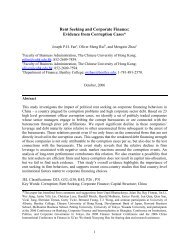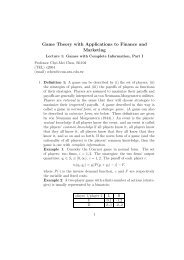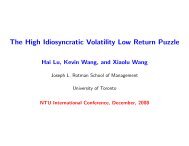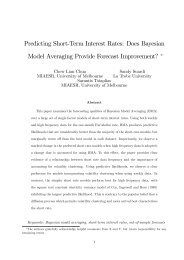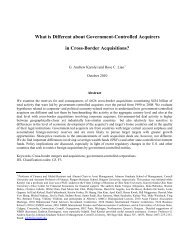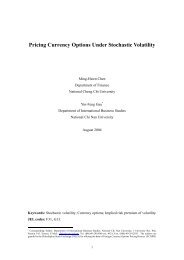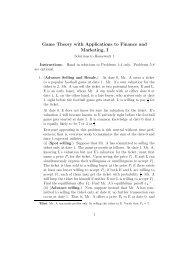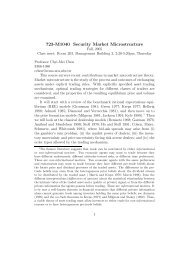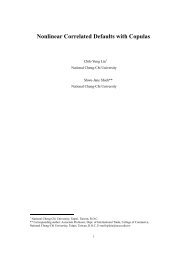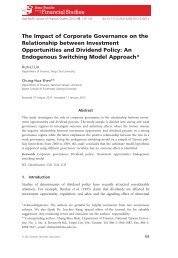Game Theory with Applications to Finance and Marketing
Game Theory with Applications to Finance and Marketing
Game Theory with Applications to Finance and Marketing
You also want an ePaper? Increase the reach of your titles
YUMPU automatically turns print PDFs into web optimized ePapers that Google loves.
<strong>and</strong><br />
⎧<br />
⎪⎨<br />
F B (x) =<br />
⎪⎩<br />
0, x ≤ p = αV<br />
1−β ;<br />
1− p x<br />
, x ∈ [p, v);<br />
1− α<br />
1−β<br />
1, x ≥ v.<br />
(10)<br />
What is the effect of an increase in α, say, on the equilibrium pricing<br />
strategies?<br />
Observe that an increase in α has two direct influences on the configuration<br />
of consumers. It implies an increase in the population of firm A’s<br />
loyals, <strong>and</strong> it also implies a decrease in the population of the switchers.<br />
The former leads <strong>to</strong> an increase in the equilibrium p (because the set<br />
of overly low prices dominated by the price V is enlarged, given that<br />
α has increased so that there are now more loyals willing <strong>to</strong> pay V ),<br />
<strong>and</strong> the latter results in an increase in the density of F A (·) for all prices<br />
below v that might arise in equilibrium.<br />
The former effect is self-evident. Let us examine the latter effect. Suppose<br />
that α 2 > α 1 , <strong>and</strong> for i = 1, 2, α i > β, α i V < (1 − β)v. Fix h, l<br />
such that v > h > l > p 2<br />
> p 1<br />
. Note that given i, firm 2 is indifferent<br />
about h <strong>and</strong> l:<br />
hβF A (h, α i )+h(1−α i )[1−F A (h, α i )] = lβF A (l, α i )+l(1−α i )[1−F A (l, α i )], ∀i = 1, 2.<br />
Since given i, hF A (h, α i ) > lF A (l, α i ), we conclude that h[1−F A (h, α i )] <<br />
l[1−F A (l, α i )] so that when α increases from α 1 <strong>to</strong> α 2 , if firm A’s strategy<br />
were still F A (x, α 1 ), then firm B would strictly prefer h <strong>to</strong> l. This<br />
result is not surprising, as an increase in α also implies a reduction in<br />
1 − α − β, <strong>and</strong> given that β does not change, firm B now considers<br />
lowering the price <strong>to</strong> win the switchers <strong>and</strong> giving up the chance of<br />
extracting surplus from the loyals more costly than before.<br />
Since only a mixed-strategy equilibrium can exist given α = α 2 , just<br />
like in the case of α = α 1 , given the new F A (x, α 2 ) firm B must again<br />
feel indifferent about h <strong>and</strong> l. We demonstrate below that this will<br />
require F A <strong>to</strong> have a higher density function under α = α 2 than under<br />
α = α 1 over the prices under v that may be chosen in both the cases<br />
α = α 2 <strong>and</strong> α = α 1 .<br />
25



